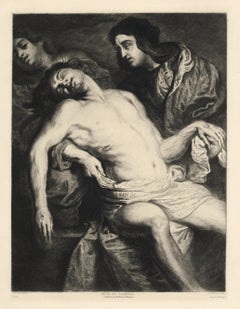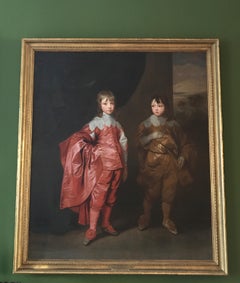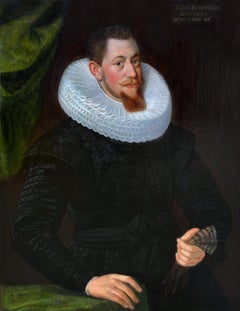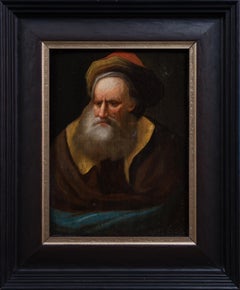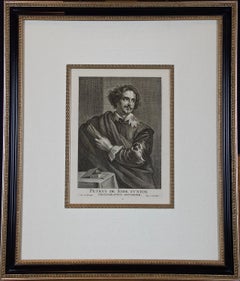(After) Anthony Van Dyck Art
Dutch, 1599-1641
Sir Anthony van Dyck (22 March 1599 – 9 December 1641) was a Flemish Baroque artist who became the leading court painter for Charles I of England. Sir Anthony Van Dyck was born in the Netherlands and painted from an early age becoming a successful independent painter in his late teens, and a master in the Antwerp Guild in 1618. He painted in the studio of Peter Paul Rubens who became a major influence on his work. Van Dyck worked in London for some months in 1621, then returned to Flanders and travelled to Italy, where he stayed until 1627, mostly in Genoa. He spent five years in Flanders after his return from Italy, and was court painter for the archduchess Isabella, Habsburg Governor of Flanders. In 1632 he returned to London to become the main court painter to Charles I of England.
After Holbein, van Dyck and his contemporary Diego Valezquez were the first painters of pre-eminent to work mainly as court portraitists, revolutionising the genre. Van Dyck is best known for his portraits of the royals and aristocracy, most notably Charles I, and his family and associates. Van Dyck widely influenced English portrait painting for the next 150 years. His portrait style changed considerably between the different countries he worked in, culminating in the relaxed elegance of his last English period. His influence extends into the modern period. During his lifetime, Charles I granted him a knighthood, and after his death Van Dyck was buried in St Paul’s Cathedral, an indication of his high standing at the time of his death.to
1
1
1
Overall Width
to
Overall Height
to
1
1
1
2
1
1
1
1
1
1
1
2
10,059
2,764
1,381
1,375
1
1
1
Artist: (After) Anthony Van Dyck
"Mise au Tombeau" etching
By (After) Anthony Van Dyck
Located in Henderson, NV
Medium: etching (after the painting). Etched by Charles Albert Waltner after Van Dyck. This impression on laid paper was printed by A. Salmon and published in Paris for "L'Art" circa...
Category
1870s (After) Anthony Van Dyck Art
Materials
Etching
Double Portrait Oil Painting Brothers George, 2nd Duke Buckingham & Lord Francis
By (After) Anthony Van Dyck
Located in London, GB
Aftrer Anthony VAN DYCK - maybe Studio (1599, Antwerp – 1641, London) Flemish
Double Portrait of George Villiers, 2nd Duke of Buckingham (1628-1687) & Lord Francis Villiers (1629-1648)
Oil on Canvas
170 x 147 cm
Anthony Van Dyck (1599-1641)
No painter has done more to define an era than Anthony van Dyck. He spent only seven and a half years of his short life (1599- 1641) in England. He grew up in Antwerp, where his precocious talent was recognised by Peter Paul Rubens, the greatest painter of his age. He worked in Rubens’s studio and imitated his style as a religious artist, painting biblical scenes redolent of the lush piety of the counter-reformation. But soon he was on the move. In 1620, he visited London for a few months, long enough to paint a history picture, The Continence of Scipio, for the royal favourite, George Villiers, Marquess of Buckingham, and a portrait of his other English patron, the great art collector, Thomas Howard, 2nd Earl of Arundel.
After a stint in Italy, making imposing portraits of the wealthy aristocracy and sketching and copying works by Titian, he returned to the Spanish Netherlands in 1627, becoming court artist to Archduchess Isabella before departing for The Hague in 1631 to paint the Dutch ruler Frederick Henry, Prince of Orange. Charles I’s invitation in 1632 led Van Dyck back to London where he was knighted, paid an annual salary of £200 and installed in a house in Blackfriars with a special jetty at which the royal barge might tie up when the King was visiting his studio. By this time Van Dyck was recognised as the leading court painter in Europe, with Velazquez at the court of Philip IV of Spain his only rival. He also excelled as a superbly observant painter of children and dogs.
Van Dyck’s notoriety in depicting children led to the introduction of groups of children without their parents as a new genre into English painting (amongst other new genres).
For the next 300 years, Van Dyck was the major influence on English portraiture. Nearly all the great 18th Century portraitists, from Pompeo Batoni and Allan Ramsay to Thomas Gainsborough and Joshua Reynolds, copied Van Dyck’s costumes, poses and compositions.
George Duke of Buckingham & his brother Francis Villiers
Painted in 1635, this double portrait was originally commissioned by Charles I, who raised the two brothers after their father, George Villiers, was assassinated in 1628. Together with their sister, Lady Mary Villiers, they enjoyed the King’s favour absolutely. Francis whose absolute ‘inimitable handsomeness’ was noted by Marvell (who was killed in a skirmish near Kingston upon Thames). The young duke who commanded a regiment of horse at the Battle of Worcester, remained closely associated with Charles II, held a number of high offices after the Restoration and was one of the most cynical and brilliant members of the King’s entourage, immortalised as ‘Zimri’ in Dryden’s Absalom and Achitopbel. As a young man he had sold his father’s great collection of pictures in the Spanish Netherlands, many of them to the Archduke Leopold Willhelm.
Painted for Charles I and placed near the portrait of their sister in the Gallery at St James’ Palace. The handling of both costumes is very rich, and the heads are very carefully and sensitively worked. That of the younger boy in particular is more solidly built up than the lower part of the figure. A preparatory drawing for the younger boy is in the British Museum.
There are copies at, e.g., Highclere Castle...
Category
17th Century Old Masters (After) Anthony Van Dyck Art
Materials
Oil
Related Items
17th century portrait of the wine merchant Caspar Rommerskirchen - Old master
Located in Aartselaar, BE
17th-century German portrait of the wine merchant Caspar Roemerskirchen at the age of 26 in 1628, Franz Kessler (attr.)
This highly decorative portrait depicts the 26-year-old Caspa...
Category
17th Century Old Masters (After) Anthony Van Dyck Art
Materials
Oil, Wood
$14,940
H 34.26 in W 21.26 in
Portrait of an Old Bearded Man
Located in Stockholm, SE
We are pleased to offer a captivating portrait, most likely painted in the late 18th century, attributed to an artist within the circle of Christian Wilhelm Ernst Dietrich. This oil ...
Category
Late 18th Century Old Masters (After) Anthony Van Dyck Art
Materials
Oil, Wood Panel
18th Century Oil on Canvas Portrait, Major Alexander Brown in Military Uniform.
By Sir David Wilkie
Located in Cotignac, FR
18th Century Military portrait of a young officer in Napoleonic period military dress. The painting is not signed but the subject is Major Alexander Brown. The work is oil on canvas later mounted on board and presented in a fine 'Regence style' carved gilt frame. There are labels to the back referring to the subject, 'Major Brown of Trinity' and a framers trade label from Edinburgh.
A magnificent and imposing portrait of a young military officer in the prime of his life. His red uniform adorned with fine buttons, fringed epaulettes and high gilt collar. His ruddy complexion offset by his stylish hair, a quiff and swept forward to the sides as was the fashion at the time.
Sir David Wilkie RA (18 November 1785 – 1 June 1841) was a Scottish painter, especially known for his portraits, including formal royal ones, and scenes from his travels to Europe and the Middle East. He painted successfully in a wide variety of genres, including historical scenes. His main base was in London, but he died and was buried at sea, off Gibraltar, returning from his first trip to the Middle East. He was sometimes known as the "people's painter".
He was Principal Painter in Ordinary to King William IV and Queen Victoria. Apart from royal portraits, his best-known painting today is probably The Chelsea Pensioners Reading the Waterloo Dispatch of 1822 in Apsley House.
Sir David Wilkie was actually admitted in 1799 (despite only being 14) through the influence of the Earl of Leven...
Category
Late 18th Century Old Masters (After) Anthony Van Dyck Art
Materials
Canvas, Oil, Board
$5,495
H 30.71 in W 25.6 in D 0.79 in
Italian 18th Century Oval Religious Oil on Canvas Painting with Saint Dominic
By Francesco de Mura
Located in Firenze, IT
This beautiful Italian 18th Century old masters oil painting on oval canvas with giltwood frame is attributed to Solimena and features a religious scene.
In this splendid oval-shaped painting are depicted Saint Dominic...
Category
18th Century Old Masters (After) Anthony Van Dyck Art
Materials
Canvas, Oil
$13,141
H 21.66 in Dm 15.75 in
Answer Within
Located in Ibadan, Oyo
Painting
Ships in a well-protected tube from Nigeria
This work is unique, this is not a print or other type of copy.
Accompanied by a Certificate of Authenticity (Issued by the Gallery)
Category
21st Century and Contemporary Old Masters (After) Anthony Van Dyck Art
Materials
Canvas, Oil
The Card Players by a Flemish 1600s Artist
By Flemish School, 17th Century
Located in Stockholm, SE
Flemish 1600s School
The Card Players
oil on oak panel
panel dimensions 22.5 x 20 cm
frame included
Provenance:
From a Swedish private collection.
Condition:
Flat and stabl...
Category
17th Century Old Masters (After) Anthony Van Dyck Art
Materials
Oak, Oil, Panel
$2,509
H 8.86 in W 7.88 in
18th century French Old Master Portrait of a woman in oriental costume
Located in Aartselaar, BE
French 18th century old master portrait of a majestic lady dressed "à la Turque"
The sitter at the viewer with a kind and enigmatic smile and twinkling eyes. She looks elegant and kind, yet also has an intelligent and determined aura, reflecting the character of someone who is in charge of her own life and destiny.
De Silvestre paid great attention to her spectacular outfit, which is striking in its portrayal of the sumptuous fabrics and their decorative richness. She is wearing a luxurious royal blue robe à la...
Category
1740s Old Masters (After) Anthony Van Dyck Art
Materials
Canvas, Oil
$22,101
H 31.89 in W 25.6 in D 0.4 in
Animated biblical scene
Located in Genève, GE
Work on canvas
Work re-lined
Plaster and gilded wood frame
86 x 105 x 7 cm
Category
Late 18th Century Old Masters (After) Anthony Van Dyck Art
Materials
Oil
Fil du Temps
By Etel Adnan
Located in London, GB
Etel Adnan "Fil du Temps" 2021. Etching on wove paper. Edition of 100.
A critical work by Adnan, the final etching in this series. Etel was unable to put pencil to paper due to her ...
Category
2010s Abstract Impressionist (After) Anthony Van Dyck Art
Materials
Etching
Thomas Hudson Style 18th Century English Portrait
By Thomas Hudson
Located in Roma, IT
Important English school painting in the style of the great artist Thomas Hudson (Devonshire 1701 - Twickenham 1779)
It depicts the portrait of Harry Gray (1715-1768), 4th Earl of St...
Category
1750s Old Masters (After) Anthony Van Dyck Art
Materials
Canvas, Oil
Christ on the Cold Stone – After Jan Gossaert (Mabuse)
Located in Stockholm, SE
This striking devotional image, painted by a follower of Jan Gossaert, represents one of the most influential compositions of the Northern Renaissance: Christ on the Cold Stone, or C...
Category
16th Century Old Masters (After) Anthony Van Dyck Art
Materials
Oil, Wood Panel
Portrait of a lady in blue dress ”Countess of Peterborough”
Located in Stockholm, SE
This exquisite portrait, with its new attribution to Theodore Russel, is believed to depict Lady Penelope O'Brien, daughter of Barnabas O'Brien, the sixth Earl of Thomond, and wife of the Earl of Peterborough, whom she married in 1644. The painting thus belongs to a historically significant period, capturing the refined elegance of the time.
The portrait has a prestigious provenance from Elleholms Hofgård, a historic estate in Mörrums socken, Blekinge, Sweden. Elleholms Hofgård, whose two-story, timber-framed main building was constructed in 1730 and expanded in 1804, has changed ownership several times since the 17th century. The ancestors of the present owners acquired the estate in 1915, and from the 20th century until 2023, this painting was prominently displayed in the estate’s main building, making it an integral part of the estate’s history.
Theodore Russel, an English portrait artist born in 1614, studied under the renowned Sir Anthony van Dyck, whose influence can be seen in Russel’s meticulous style. Russel often painted on cabinet-sized panels, such as this one, which measures approximately 39 x 31 cm. This preference for panels is a notable characteristic that sets him apart from contemporary artists like Sir Peter Lely, who exclusively used canvas. The size of the panel is a key reason for the reattribution to Russel from Peter lely, as Lely never used panels for his works. This distinctive format, along with Russel’s characteristic style, strongly supports the new attribution.
Russel, the son of Nicasius Rousseel, a goldsmith and jeweler to James I and Charles I, refined his skills under the mentorship of his uncle, the famous portrait painter Cornelis Janssen. He also worked as an assistant and copyist for van Dyck, further honing his artistic style. This captivating portrait exemplifies Russel’s craftsmanship, reflecting the elegance of the period’s fashion and the artist's refined techniques.
oil on wood panel
with indistinct inscription Countess of Peter[...] upper left.
with inscription on the reverse: ”Countess of Peterborough. P. Lely 1670. S Beatty Picture Restorer [...] Warwick”.
unframed 39 x 31 cm = 15.35 x 12.2 inches
framed 52 x 41.5 cm = 20.47 x 16.34 inches
Condition:
The portrait has just been restored by a professional art conservator in Stockholm and is now in a very good condition. The colors are vivid, and the skin tones appear more natural than before. It is a very fine painting. The frame is newly made and included.
Provenance:
Elleholms Hofgård, Mörrums socken, Blekinge, Sweden **;
Stockholms Auktionsverk, Fine Art & Antiques Autumn...
Category
17th Century Old Masters (After) Anthony Van Dyck Art
Materials
Oil, Wood Panel
$11,349
H 20.48 in W 16.34 in
Previously Available Items
A Framed Portrait of Old Master Artist Petrus de Jode by Anthony van Dyck
By (After) Anthony Van Dyck
Located in Alamo, CA
This is a portrait of the old master artist Petrus (Pieter) de Jode, the Younger. The engraving was done by his father Petrus de Jode, the Elder after a drawing by his fellow 17th century old master artist Anthony van Dyck, from his famous Iconography series (L'Iconographie d'Antoine Van Dyck) of portraits of eminent people of the day, many of them contemporary artists. The engraving depicts de Jode standing behind a table with engraving tools. Although originally produced in 1645, the exact date of this printing can not be determined.
This Van Dyck portrait is presented in an attractive gold and black-colored wood frame and a cream-colored silk mat. The frame is embellished with ornate gold-colored inner and outer trim and a gold-colored fillet in the style of the frame trim. There are two tiny faint spots in the left lower margin corner and a darker spot in the lower margin that may have occurred during printing. The frame and mat style are identical to another old master print listed on 1stdibs, an 18th century satirical print by William Hogarth entitled: "Some Principal Inhabitants of ye Moon: Royalty, Episcopacy and Law". This print can be viewed by placing the 1stdibs reference # LU117327130472 in the search field. These two framed prints would make a striking display grouping. A discount is available for purchase of the pair.
Sir Anthony van Dyck (1599-1641) was a Flemish Baroque artist who was a pupil of Peter Paul Rubens. He eventually rose to prominence in the Netherlands and Italy before becoming the main portrait painter in the court of King Charles I of England...
Category
Mid-17th Century Old Masters (After) Anthony Van Dyck Art
Materials
Engraving
(after) Anthony Van Dyck art for sale on 1stDibs.
Find a wide variety of authentic (After) Anthony Van Dyck art available for sale on 1stDibs. You can also browse by medium to find art by (After) Anthony Van Dyck in canvas, engraving, etching and more. Much of the original work by this artist or collective was created during the 18th century and earlier and is mostly associated with the Old Masters style. Not every interior allows for large (After) Anthony Van Dyck art, so small editions measuring 8 inches across are available. (After) Anthony Van Dyck art prices can differ depending upon medium, time period and other attributes. On 1stDibs, the price for these items starts at $100 and tops out at $53,681, while the average work can sell for $4,359.
Artists Similar to (After) Anthony Van Dyck
Questions About (After) Anthony Van Dyck Art
- 1stDibs ExpertOctober 30, 2024How much a van Dyck painting is worth varies based on its historical significance, condition and size. At a London auction in 2009, a self-portrait of the artist sold for $13.5 million. Sir Anthony van Dyck was a Flemish Baroque artist who became the leading court painter for Charles I of England. He is best known for his portraits of royalty and aristocracy, most notably Charles I and his family and associates. His style changed considerably between the countries he worked in, culminating in the relaxed elegance of his last English period. Van Dyck widely influenced English portrait painting for the next 150 years, and his influence extended into the modern period. If you own a van Dyck piece, use the services of a certified appraiser or knowledgeable art dealer to learn how much it may be worth. On 1stDibs, find a variety of Baroque art.
